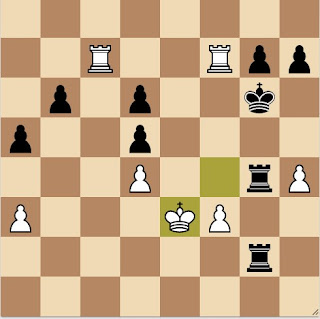Whose Double Rooks are Faster
Someone theorized that frequency of rook and pawn endings stems from the late entry of the rooks into the game, being the last pieces to be developed. Well, I am not too convinced by it. Rooks can be exchanged off in the middlegame, and that is not uncommon. Rooks need space and long avenues of attack plus coordination.
With 31. Kf4, I threatened a mating pattern with the rooks by harassing the Black king along the 7th and 8th ranks. It will be tight and perilous for the Black king if the rook on c3 gets to c7. Black countered with 31...R2g2, connecting his rooks and drumming up a mating attack of his own. Play went on with 32.R3c7+ Ke6
33.Re8+ Kf6 34.Rf8+ Ke6 35.Re8 Kf6 and we agreed to a draw. I was contented with a draw since my clock came very close to flag down and thus forfeiting the game to time. However, out of curiosity, I submitted the position to computer analysis to see if there was a way to victory.
Computer analysis suggested 36.Ree7 which increases the possibility of a mate. The mate would consists of White rooks on f7 and e7 with the Black king not having a way out.
The Black king required a free square to dodge the attacking rooks. The rook on g6 needed to move out. The moves would go 36...Rg6 37.Rf7+ Kg6 to which White should respond, not with 38.Rg7+, but with the 38.h4!
If 38...Rh5, then 38.Rg7+ winning the Black rook on g2. So, 38...R5g4+
At this point, White should play another finesse move 39. Ke3! and Black is surely to lose a rook. If Black plays 39...Rh4, then 40.Rg7+. Note that 39. fg4 , instead of 39.Ke3, capturing the rook, there follows 39...Rf2+ recovering the rook via f7.










